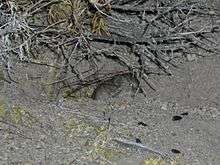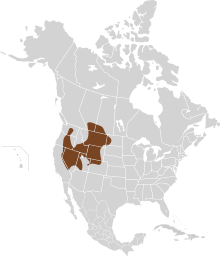Sagebrush vole
The sagebrush vole (Lemmiscus curtatus) is a tiny vole found in western North America. This is the only member of genus Lemmiscus.
| Sagebrush vole Temporal range: Middle Pleistocene - Recent | |
|---|---|
 | |
| Scientific classification | |
| Kingdom: | Animalia |
| Phylum: | Chordata |
| Class: | Mammalia |
| Order: | Rodentia |
| Family: | Cricetidae |
| Subfamily: | Arvicolinae |
| Genus: | Lemmiscus Thomas, 1912 |
| Species: | L. curtatus |
| Binomial name | |
| Lemmiscus curtatus (Cope, 1868) | |
 | |
They are somewhat similar in appearance to lemmings. They have chunky bodies with short legs and a very short tail which is covered in fur and lighter below. They have fluffy dull grey fur with lighter underparts. They range from 11–14 cm in length with a tail length of around 1.8-2.7 cm and a mass of around 21-39 g.[2]
These animals are found in dry open brushy areas in the western United States and southern parts of western Canada. They feed on grasses and leaves in summer and sagebrush, bark and twigs in winter. Predators include owls, coyotes, bobcats and weasels.
Female voles have 5 or more litters of 4 to 6 young in a year. The young are born in a nest in a burrow.
They are active year-round, day and night, but are usually more active near sunrise and sunset. They make trails through the surface vegetation and also dig burrows with many entrances. They burrow under the snow in winter. These animals are often found in colonies.
References
- Linzey, A.V. & Hammerson, G. (NatureServe) (2008). "Lemmiscus curtatus". IUCN Red List of Threatened Species. 2008. Retrieved 5 June 2009.CS1 maint: ref=harv (link) Database entry includes a brief justification of why this species is of least concern.
- Pattie, Donald L. (1999). Mammals of Alberta. Fisher, Chris C. (Christopher Charles), 1970-. Edmonton: Lone Pine Pub. ISBN 1551052091. OCLC 43275742.
